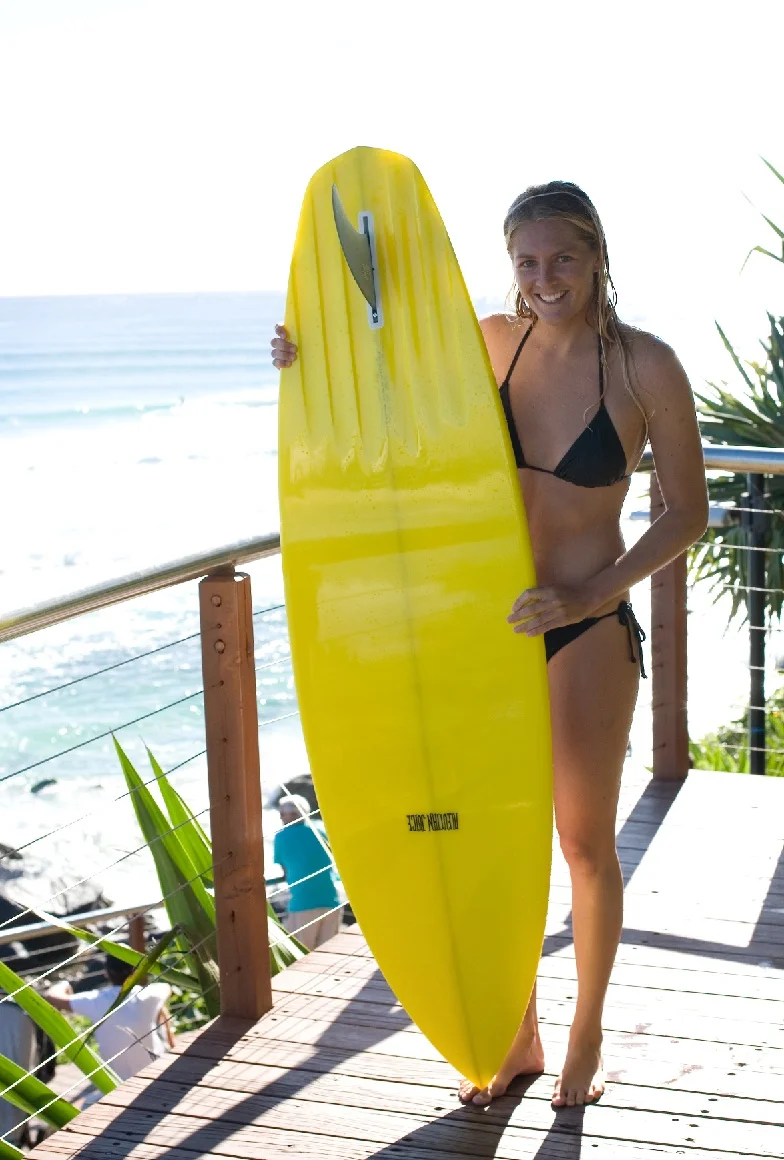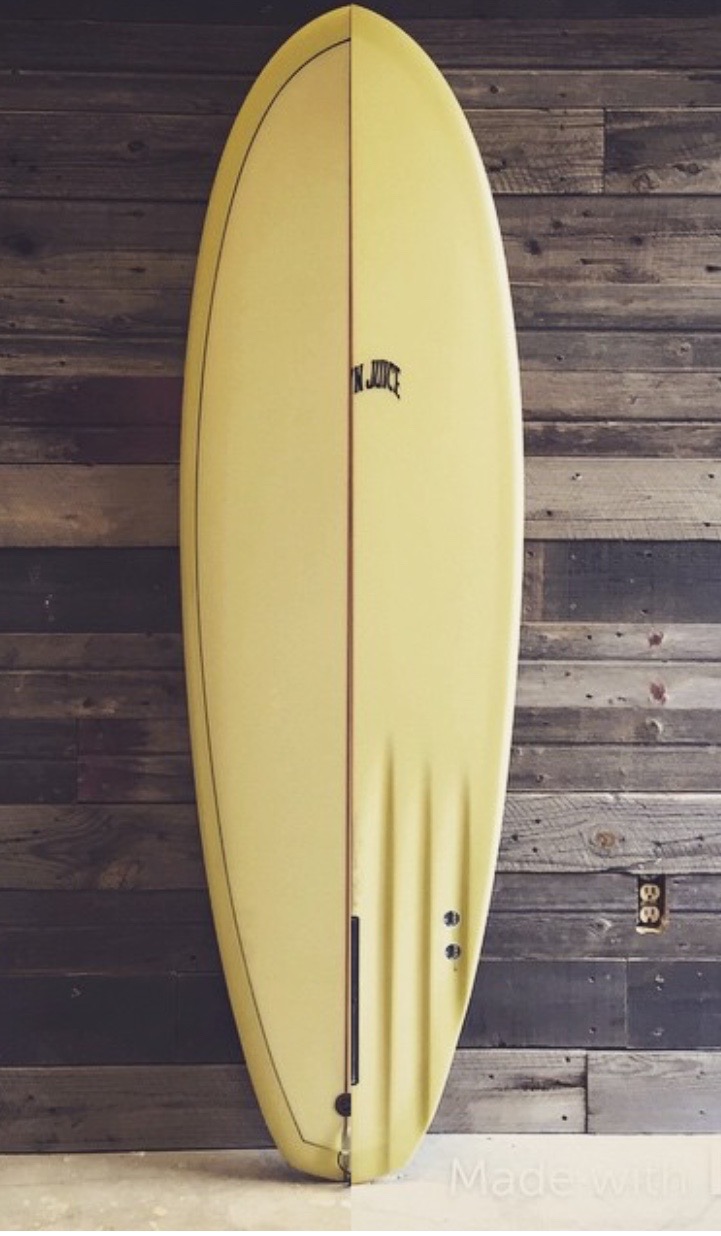Nowtro Models
Widow-maker | Straight Single Fin | MP Disc | Occ-Ster | I'a Auna (Modern Fish)
Some of the best-riding surfboards on Earth right now are so-called ‘retro’ designs refined and modernized by cleaner or more sensible components. If it worked good in the 70s or 80s, then it follows that it will only work better today by applying all that we’ve learned over the past 30 or 40 years. That’s the Nowtro ethos…
Widow-maker
The original Widow-maker I shaped in 1988 for an extended surfari to Jeffrey’s Bay. On previous trips there I had been unhappy with my tri-fins, as they simply wouldn’t allow me to ride that most epic of down-the-line waves with the tracks I wanted to follow left by Terry Fitzgerald, Jonathan Paarman, and Reno Abellira from single-fin days. The 6’9” I shaped and took to South Africa altered all my convictions about surfboards and forced me to realize that I was essentially a single-fin surfer at heart. The 6’9” was a wickedly pintailed rocket with a wider and thicker nose, a widepoint placed well forward of center, channels running off the tail, and for an engine a classic Brewer-style single fin set off by a pair of small finlets glassed beside it on each rail. These small side fins give the board a slight tri-fin turning axis and bite off the top at high speeds, but grant versatile single-fin neutrality off the bottom, allowing you to surf the wave rather than the board – with jazz-like riffs and sudden pit-stalls if necessary.
The Widow-maker is more than just a turbo-boosted single-fin. It’s a design that lets you go fast when you want; and stop dead in your tracks if the wave calls for it. It allows you to use the entire wave face in complete control, without having to go through the classic tri-fin triple pump wind-up every time you want to do a maneuver.
For guns the Widow-maker delivers all the benefits of a single-fin – lower drag, no high-speed max-outs, meaningful bottom turns and greater control in the barrel – yet with the low profile small Widow-maker side fins there’s still always that subtle snap and bite in top turns and cutbacks. The Widow-maker fin configuration adapts well to most designs, but especially big-wave guns and single-fin shapes over 6’5”.
And by the way, the Widow-maker is named after the classic Winchester repeating rifle, the firearm that won the West….
Widow-maker fin array available on all designs.
Retro to modern single-fin designs from 5’10” to 7’0”
Guns from 7’0” to 11’0”
Widow-maker center and side box/plug fins available
Standard Widow-maker fin placement: The board itself is designed around where the center single fin would go on a straight single. The side fins are then placed so that the rear bases are lined up with the front base of the center single fin. This provides a fairly neutral single fin handling: classic unfettered single fin bottom turns but with just enough claw and bite off the top.
6'6" with a 70/30 ratio of retro to modern design attributes.
7'2" Widow-maker for Carl Wieser, reminiscent of the Free Ride era, widepoint up about 4", eagle beak nose, angular boxy rails in the Brewer/Parrish school.
Straight Single Fin
5’8” to 7’0”
As a surfboard design the single-fin has always been maligned by the myth that they are ‘stiff’ handling surfboards. Actually, they are much looser than multi-fin boards, though the rider must really know how to surf to get them moving in ordinary conditions. You cannot simply pump away with Thruster body English and get them up on step. In fact, that is one of the main reasons singles are in fashion again – they teach you how to surf properly, using the rails and trim, and tapping energy zones on the wave unreachable on the tri-fin with it’s power-giving but grabby side fins. Many younger surfers are discovering the single-fin for the very reason that it lets them ‘feel’ the wave in an entirely way, with almost LSD-like sensation and clarity.
Ride them full-vintage or in modern configurations, either way the single-fin allows the experienced surfer a limitless array of tracks on a wave, with an enhanced tactility of control in tight spots, and with Michael Peterson-like riffs that have you kicking out thinking, “What was that!”
Standard Dimensions for typical 50/50 Retro/Modern blend:
- 6’0” to 6’9” 12.5” Nose
- 19. 5” Widepoint
- 13.5- 14.0” Tail 2.5” to 2.65” thickness.
Glass-on single-fin or center box for experimentation.
Deep six-channel bottom highly recommended for enhanced drive with out the drag of multiple fins.
Stephanie Gilmore on her 6'1" X 19.5 X 2.35" V6 single fin, from Andrew Kidman's Spirit of Akasha
Channel bottoms come in all sorts of lengths, depths, and widths. And with many rationales. My own design theory is to arrange the depths and lengths somewhat unequally and in conjunction with the fin so that the grip tied in to a back foot used to Thrusters; and also especially that the channels never extend out of the influence of the back foot.
World Surfing Champion Stephanie Gilmore at Kirra with her SGXP MkI
Custom gun fin (Brian Keaulana template, foiled by Brian Bills at BC Rudders on Oahu) on a 9'6" rhino chaser for Mark Renneker.
MPegg
5’6” to 7’0”
The MPegg is a component-specific replica of the stubby Michael Peterson rode at Kirra in Morning of the Earth. All the funky elements are filtered out and what remains is Fish-like speed in a large bore single-fin that is both fun-ctional in slop and a source of new sensations and lines in perfect point surf.
Active ingredients:
- Wide and short planshape with widepoint well above center serves to lengthen and straighten rail line, which gives loads of speed and projection out of a super-short board.
- Slight convex ‘hull’ bottom nose blends to flat and crisp vee panel at tail. Combined with a low rocker, this is one efficient hybrid planing/displacement hull.
- Soft, low 70/30 rails allows full attack without skittering, yet also buries a lot of thickness without being blobby.
Standard dimensions:
- 16.5” – 17” Nose
- 21.0” Widepoint
- 15.0” – 15.5” Tail
- 2.75” to 3.0” Thickness
Single flex fin in center box; also adaptable to tri-fin or quads.
The MPegg is not a set design and can be expanded or narrowed, thickened or thinned, finned or de-finned to suit the rider's taste.
Occ-Ster
6’0” to 6’8”
In 1984 Rusty Preisendorfer made a 6’1” tri-fin and handed it to young Aussie firebrand Mark Occhilupo. As surfed by Occy, this board brought the 3-year-old Thruster concept into full fruition. The pairing of Occy’s explosive carving lines and Rusty’s precise and quantitative shaping approach made surfboard design history. Few people today realize that that original Rusty/Occy board was over 20” wide and had a 16” tail – the dimensions are pretty much that of a Micro-Stubby now. As a member of the Rusty surf team at the time, I had dozens of these sorts of surfboards. By about 1985 it was only half-jokingly asserted that half the ASP Top Sixteen were riding Rusty boards and the other half were on Channel Islands. The surfers who preferred Merrick’s shapes liked their neutral, almost submissive handling, while those who opted for Rusty’s boards favored the stiffer but drive-ier qualities derived from the stored energy of the boxier rails and thin, less tapered thickness distribution. When I began shaping under Rusty’s label in 1988, I received copies of all the original templates and have never stopped making those Occy-type boards for myself, and about 15 years ago they began coming into vogue again because modern surfboard design had become too anorexic for most surfers. The Occster IS a modern shortboard – it just puts the ‘THRUST’ back into THRUSTER.
Active Ingredients:
- Widepoint at center on a slightly wider and more balanced planshape than contemporary shortboard which delivers more useable rail for drive and projection when compressed and released into turns.
- Relaxed bottom rocker brings back the glorious skatey glide over flat spots possessed by mid-80s tri-fins.
- Period medium-boxy rails with a crisp tucked under edge restore the bite and release to today’s blobby round rails.
- Wider bump-squashtail with slightly inverted vee panels create an accelerator pedal for your back foot.
Standard dimensions:
- 12.0” Nose
- 19.25” Widepoint
- 14.75” Tail
- 2.375 Thickness.
Tri-fin.
6'5" X 19.5" X 2.45" Occ-Ster, putting the 'thrust' back in Thruster.
I'a `Auana (Modern Fish)
5’6” to 6’2”
A true postmodern surfboard design, the Fish has made a triumphant return to surfboard racks over the past fifteen or twenty years. And not only because it’s a timeless design. The Fish revival perfectly tracked alongside the dissolution and cachexia of the modern shortboard. As volume, straights and flats were eroded from the contemporary shortboard by Slatermania, they reappeared on alternative surfcraft like the Fish. A potent small-wave speed machine, the Fish is not a perfect or even very versatile design, but it’s blinding horizontal acceleration forced many surfers struggling on fashionable but submerged shortboards to reappraise retro components.
Active ingredients:
- Short, wide and flat … there’s a reason bodyboards are so damned fast!
- Wide point well up past center, which allows for a longer and straighter ‘waist’ back to the enormously thrust-giving wide fish tail. This provides enormous drive and projection for such a short surfboard.
- True Fish designs should have a nose wider than the tail, as well as a corresponding nose foil – all the volume should be pooled forward of center and thin out drastically at the tail.
- Twin keel fins on each rail create a lot of drive horizontally and have a loose and lightning fast skittery feel when banked up on a rail.
Standard dimensions:
- 16.5” Nose
- 21.5” Widepoint
- 16.25” Tail
- 2.5” to 2.65” thickness.
Twin keel fins set further back than modern twin fins.
The Fish design has come in an out of vogue 3 or 4 times since their inception over 4 decades ago. In this most recent embracing of this open-source Pinewood Derby foam block they have proven to be an eye-opening antidote to the shortcomings of the, uh, shortboard today.











